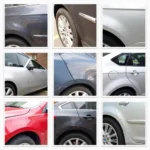Choosing the best welder for car body repair can feel overwhelming with so many options available. This guide will break down everything you need to know, from understanding different welding types to selecting the perfect machine for your needs, whether you’re a seasoned professional or a DIY enthusiast. We’ll cover MIG, TIG, and spot welders, helping you make an informed decision for your car body repair projects.
Understanding Different Welding Types for Car Body Repair
Different welding processes offer unique advantages and disadvantages for car body work. Let’s explore the most common types:
MIG Welding (Metal Inert Gas)
MIG welding is incredibly popular for auto body repair due to its ease of use and versatility. It uses a continuously fed wire electrode shielded by an inert gas, typically argon or CO2, to protect the weld from atmospheric contamination. MIG welders are excellent for sheet metal work, making them ideal for patching holes, repairing rust damage, and joining panels. They work well on various thicknesses of steel and even some aluminum alloys found in modern vehicles.
TIG Welding (Tungsten Inert Gas)
TIG welding, also known as Gas Tungsten Arc Welding (GTAW), provides exceptional precision and control. A tungsten electrode creates the arc, and a separate filler rod is used to add material to the weld. TIG welding allows for cleaner, more aesthetically pleasing welds, perfect for visible areas on your car body. While it demands more skill than MIG welding, the results are worth it for achieving high-quality, durable repairs.
Spot Welding
Spot welding is a resistance welding process commonly used in auto body factories. It joins two pieces of metal by applying pressure and localized heat through copper electrodes. While incredibly efficient for joining sheet metal, dedicated spot welders are less versatile than MIG or TIG machines for general car body repair. They are, however, essential for replicating factory-style welds when replacing panels or performing structural repairs.
After this introduction to the various types of welders, you might find our article on car body repair machine helpful for a broader perspective on auto body repair equipment.
Choosing the Best Welder: Key Considerations
Selecting the best welder for car body repair depends on several factors. Consider the following:
Material Thickness
The thickness of the metal you’ll be welding dictates the power and capabilities required from your welder. For thin sheet metal common in car bodies, a lower amperage MIG welder is typically sufficient. Thicker materials necessitate a more powerful machine.
Power Source
Welders operate on either 110V or 220V power. 110V welders are portable and convenient but have limited power. 220V welders offer higher power and duty cycle, essential for more demanding tasks.
Budget
Welders range from affordable entry-level models to high-end professional machines. Determine your budget and prioritize features that align with your needs and skill level.
Duty Cycle
Duty cycle represents the percentage of time a welder can operate at a specific amperage before overheating. Higher duty cycles are crucial for extended welding sessions.
“Investing in quality car body repair ware is crucial for achieving professional results,” emphasizes Robert Johnson, Lead Auto Body Technician at Elite Auto Restoration. “Choosing the right welder can significantly impact the longevity and quality of your repairs.”
Best Welders for Car Body Repair: Our Top Picks
Here are some recommended welders based on different needs and budgets:
- Entry-Level: For beginners and occasional use, a 110V MIG welder is a great starting point.
- Mid-Range: Consider a 220V MIG welder for more power and versatility, suitable for a wider range of car body repairs.
- Professional: TIG welders offer superior control and weld quality for professional auto body work.
Maintaining Your Welder
Proper maintenance is essential to ensure the longevity and performance of your welder:
- Regularly clean the welder to remove dust and debris.
- Check and replace worn-out parts like tips, nozzles, and liners.
- Store the welder in a dry, protected environment.
Don’t forget to explore reputable car body repair tool suppliers for all your welding needs and accessories.
Conclusion
Choosing the best welder for car body repair requires careful consideration of your specific needs, skill level, and budget. Whether you opt for a MIG, TIG, or spot welder, understanding the strengths and limitations of each type will empower you to make the right decision. By investing in the right equipment and maintaining it properly, you can achieve professional-quality car body repairs.
FAQs
-
Q: What type of welder is best for beginners? A: MIG welders are generally the easiest to learn and use for car body repair.
-
Q: Do I need a 220V welder? A: If you plan on welding thicker materials or require a higher duty cycle, a 220V welder is recommended.
-
Q: Can I use a MIG welder for aluminum? A: Some MIG welders can handle aluminum with the correct wire and gas setup.
“Always prioritize safety when welding,” advises Maria Sanchez, Certified Welding Instructor. “Proper ventilation and protective gear are essential for protecting yourself from fumes and sparks.”
Looking for specialized tools? Check out our guide on car body dent repair tools. You might also find our resources on car body repair tools australia helpful if you are located in Australia.
Need assistance with car repairs? Contact us via WhatsApp: +1(641)206-8880 or Email: [email protected]. Our 24/7 customer support team is ready to help.

